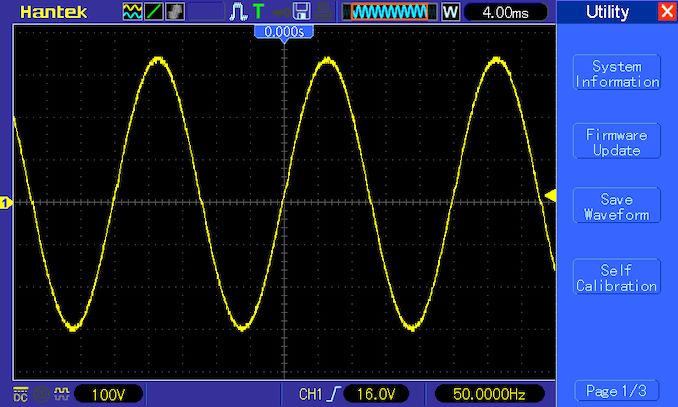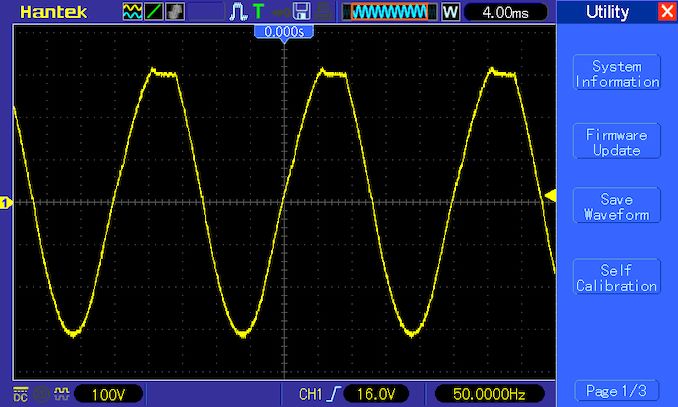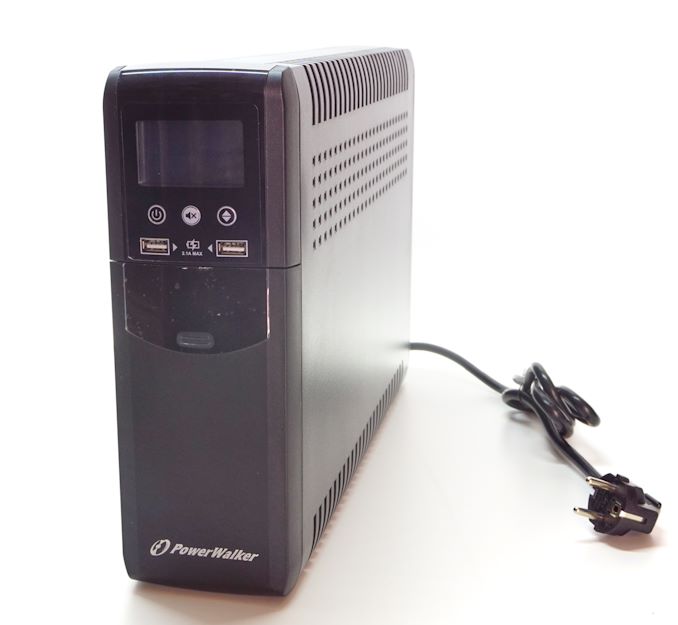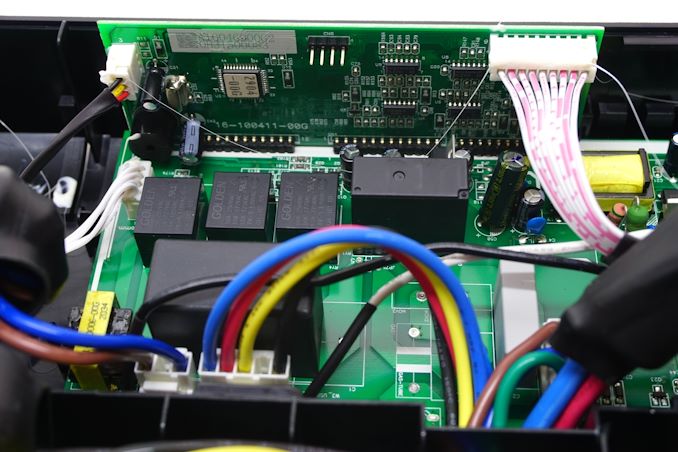The PowerWalker VI 1500 CSW UPS Review: Trying For True Sinewave on a Budget
by E. Fylladitakis on April 13, 2022 8:00 AM EST- Posted in
- Cases/Cooling/PSUs
- UPS
- PowerWalker
- BlueWalker
- 1500VA
Testing
Putting the PowerWalker VI 1500 CSW to the test, the basic electrical figures of the UPS are acceptable, with the unit delivering the performance it promises. When it operates on battery power, the voltage output is exactly 224 V RMS regardless of the load. There are minor frequency variations but these are exceptionally small. The transfer time is relatively high, yet not out of the manufacturer’s specifications. Though it also seems to significantly depend on the load, which should not be happening to this extent.
| UPS Load Performance | |||||
| 10% | 25% | 50% | 75% | 100% | |
| Voltage Output (Vrms) | 224 | 224 | 224 | 224 | 224 |
| Frequency (Hz) | 50.05 | 50 | 50 | 49.95 | 50 |
| Transfer Time (ms) | 6.1 | 7.6 | 7.8 | 7.6 | 8.9 |
The fan of the unit outputs 41.6 dB(A) once it is running. By UPS standards this is not a very high figure, but it's certainly not a very comfortable amount of noise, either. The downside here is that the PowerWalker VI 1500 CSW requires nearly 10 hours to fully charge its batteries once they are completely empty, which could be a problem with the unit installed in a living room or, worse, bedroom.
In our load testing, we've found that the battery runtime of the PowerWalker VI 1500 CSW is even better than advertised. These figures are achieved with its batteries fully charged and while they are new.
The PowerWalker VI 1500 CSW boasts true sinewave output, and our testing confirms this. Under load, our instruments showing a nearly-perfect sine wave with the unit running on battery power – but only while the load is low. Once the load reaches 50% (450 Watts) the deformation of the sine wave becomes apparent. It also becomes deformed abnormally, with only the positive peaks getting chopped, meaning that it is only one half of the circuitry failing to perform. At nearly 90% load (800 Watts) the waveform is nearly square, with both peaks heavily chopped, suggesting a massive number of harmonics. This will definitely not be healthy for any device that requires a pure sinewave input, such as APFC circuitry and AC motors.
Conclusion
The PowerWalker VI 1500 CSW is a UPS designed to combine a high output and true sinewave capability at a retail price affordable for most home consumers. At around €180, it currently retails for half of the price reputable manufacturers ask for their equally powerful true sinewave products, making it a very enticing deal.
The build quality of the PowerWalker VI 1500 CSW is better than one would expect from a product retailing at this price. Its parts are coming from reputable manufacturers and the unit is very well assembled. The design is dated but that is not inherently wrong – it just means the unit isn't geared to deliver the kind of top-of-the-line performance that more recent designs can provide.
When it comes to performance, the PowerWalker VI 1500 CSW performs, for the most part, according to its specifications. The trade-offs and issues become apparent when a closer look is taken, revealing that its electrical performance leaves a lot to be desired. The unit fails to maintain a true sinewave output when the load exceeds about 25% of its rated capacity, which could lead to serious issues if an application requires a true sinewave input. To be sure, for most home applications like modern PCs and TVs, this will not be a significant issue, as they take measures against harmonics and the expected load is usually but a fraction of the unit’s maximum output. However, if the unit needs to run at its maximum output or to drive loads that are very sensitive to harmonics, such as electric motors or older PCs, it could have damaging results to the equipment.
Ultimately, for users who are currently on the market for a UPS that is expected to mostly run at low loads, such as for safeguarding a single PC and its peripherals, the PowerWalker VI 1500 CSW is a fine choice. The UPS offers a clean enough electrical feed to meet the needs of a PC (or similarly switching power supply device), and it has the headroom to handle the stress if the power outage happens when the system is very heavily loads (e.g. while gaming). However, it is very clearly a device that was designed against engineering trade-offs to bring down costs for its target market. So, due to its inability to maintain a clean true sinewave output, we cannot recommend it for sensitive applications, and prospective users will want to be especially careful analyzing the sensitivity of their equipment to harmonics before purchasing it.
















107 Comments
View All Comments
sor - Wednesday, April 13, 2022 - link
I'm probably in the minority, but I have an 8 hour whole house battery backup. The UPS is here at my desk to gap the moments it takes for that to kick in.That said, I've got two computers, my network gear, and a 38" monitor plugged into a small-ish Back-UPS Pro 1000S and the load currently says 72W with an estimated backup time of 53 minutes.
Also, the majority of power outages in my area (maybe once a year) last less than a minute.
Mikewind Dale - Wednesday, April 13, 2022 - link
A friend of mine has a gas generator that takes a few seconds to kick in, so I told him to buy a Cyberpower CP1500PFCLCD PFC Sinewave UPS for his ThreadRipper Pro 3955WX. And it works.t.s - Thursday, April 14, 2022 - link
Very nice electricity there. Here, at least in a month (average), there's 1 time power outages and usually goes for 2 hours.Thunder 57 - Friday, April 15, 2022 - link
Not sure where you are from but I took a battery just the other day to Home Depot. There was a bin just for batteries you could toss them in. There are other places that do that too. And yes, a UPS on a modem/router is very nice to have. Keeps your internet up and you can use a tablet/laptop for plenty of time.Lezmaka - Wednesday, April 13, 2022 - link
I'm just one person (physically, mentally... that's still undetermined) but I liked this. With more people (like me) working from home hopefully there's enough interest to see more of these. I'd personally like a little more educational commentary, either as part of reviews or guides, but hope to see more of these.jamesindevon - Wednesday, April 13, 2022 - link
Great review - thanks. It could have done with a mention of the USB socket around the back -- it should be there so attached PCs can power down safely when the unit goes to battery power. A few words on this and any provided software would have been good (can one PC send a shutdown signal to another?)Also, you might want to mention that European grid frequencies vary a lot more than this unit.
romrunning - Wednesday, April 13, 2022 - link
I am interested in seeing some APC reviews, especially at 1k+. APC (Scheider Electric) still seems to be the market leader in North America, so would love to see their products reviewed. My favorite does seem to be the 1500VA spot, so I'm curious to see whether the savings on the cheaper CyberPower is worth it.tyger11 - Wednesday, April 13, 2022 - link
I went with CyberPower units after an APC one died on me, and I've never looked back,domih - Wednesday, April 13, 2022 - link
Same here. I've a few APC ones which I bought when CompUSA (brick and mortar) died and was selling them at a quarter of the price by the last week. Otherwise I have many more CyberPower. No problems with both brands. Both brands did their job several several time during power outages. Meaning: the power went down for a few seconds and the computers did not mind. Or the power was out for hours and I had time to do normal shutdowns (automatic or manual). Contrary to APC, the CyberPower Windows Server software app was free. I don't really care anymore because I switched to Linux years ago. I also got several additional APC and CyberPower for free from a company that did not want them anymore and was on the verge to e-waste them. Like my first generation of UPSes I just replace the batteries and they were like new. All the models I have from both brands use the same battery anyway: any equivalent to DURACELL DURA12-8F2 12v 8Ah AGM. I went to a local brick and mortar battery retailer. He smiled and gave me a good discount when I ask the price for 24 units :-)mode_13h - Wednesday, April 13, 2022 - link
I had a Cyber Power CP685AVRLCD fail pretty badly on me, after about 5-6 years of use. I seem to recall it emitted a strange noise and started emitting a funny odor, not prompted by any sort of power event that I could discern. I can't remember if it also cut power to the outlets, but I think so.We've had a couple APC units fail, at work. The most common thing I see is that a unit appears completely bricked, but the issue is that its battery is simply too dead. As a result, it gives no signs of life when plugged in. After installing a fresh battery, they seem to return to fully working status. However, I'm not counting that as "failed" - I just mention it as a caution to anyone who thinks they need to dump an old UPS that *seems* dead, after not being plugged in for a long time.
Keep your UPS's plugged into A/C, even if you're not using them! Lead acid batteries DO NOT like deep discharges!
Anyway, we have some APC rack mount units are probably 20 years old and still kicking. They're not on anything mission-critical, so as long as they don't catch fire or something, there seems to be no need to replace them.